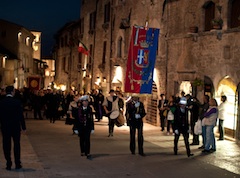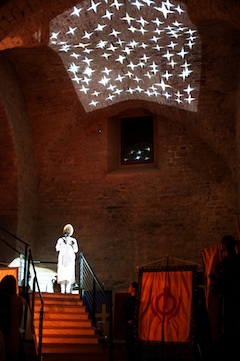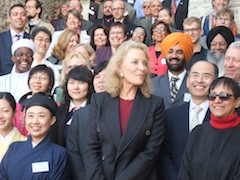Green Pilgrimage Network launches in faith, hope and joy
 |
 |
 |
Procession at the start of the Green Pilgrimage Network launch, Assisi, Italy |
This page has not been updated since June 2014.
A ban on cars on pilgrimage routes; solar panels for cathedral roofs; provision of fresh clean, water for pilgrims, and the planting of thousands of trees around sacred sites - these are just some of the initiatives which the founder members of the Green Pilgrimage Network have pledged to implement.
The Green Pilgrimage Network was launched at the Sacred Land Celebration in Assisi, Italy, which ran from October 31 to November 2, 2011, and was organised by the Alliance of Religions and Conservation (ARC) in association with WWF.
Representatives from 15 faith traditions from around the world gathered in the holy city of Assisi, Italy – one of the founder members – with secular and environmental organisations to launch the world's first global commitment to green pilgrimage.
 |
| "This is an invitation to all holy places to put into practice what they preach – namely, that when we walk upon this Earth, we walk on sacred land” - Martin Palmer, ARC Secretary-General |
|
 |
 |
ARC Secretary-General Martin Palmer said: “Cities from China to Norway and faiths from all around the world today commit to making one of the most powerful religious experiences – pilgrimage – a living witness to a commitment to protect our living planet.
“This idea does not belong to these founder members or even to ARC or WWF. This is an invitation to all holy places to put into practice what they preach – namely, that when we walk upon this Earth, we walk on sacred land.”
Around 100 million people a year become pilgrims, whether for a few hours, days or even weeks, according to figures compiled by ARC. The Green Pilgrimage Network brings together faiths and local governments to make their pilgrim cities and sacred sites as environmentally sustainable as possible, according their own theologies and understanding of the natural world.
A ban on cars on pilgrimage routes is part of the Green Pilgrimage plan of Kano, Nigeria; solar panels are to be installed on St Albans's cathedral roof in the UK; provision of fresh clean, water is to be provided for pilgrims to the Golden Temple in Amritsar, India, while the planting of thousands of trees around sacred sites is an initiative of Etchmiadzin, Armenia.
Other plans announced today by the 12 founder Green Pilgrimage Network members include measures to protect nature (Louguan, China), teaching children about conservation (Luss, Scotland); protection of sacred forests (Jinja Honcho, Japan), reducing waste and encouraging recycling (Haifa, Israel); organising nature tours for pilgrims (Assisi, Italy)
In addition:
Trondheim, Norway, is developing environmental award certificates for local restaurants and hotels, as well as for church buildings;
St Pishoy Monastery in Egypt, already a model of environmental sustainability, plans to become self sufficient in food for monks, labourers and pilgrims.
Dramatic opening procession
 |
 |
 |
A dazzling celebration featured music, dance, ritual and teaching from many religions and cultures |
The event opened on Monday October 31 with a procession – with banners, flags, drummers and torch-bearers – of religious delegates, led by Her Royal Highness Princess Michael of Kent, herself a devout Catholic, who represented ARC’s founder, the Duke of Edinburgh, who was unable to attend due to illness.
It was followed by a dazzling celebration bringing together music, dance, ritual and teaching from many religions and cultures, illustrating their common sacred mission to care for the natural world with examples of projects worldwide, and a banquet in the 13th century Palazzo Monte Frumentario.
HRH Princess Michael of Kent read Prince Philip’s speech, in which he recalled how the first Assisi event in 1986 was to see how the faiths could work with the conservation movement to protect Nature.
“It seemed to me that if someone believes that all of life was created by God this should mean they would feel a sense of responsibility to protect the handiwork of God,” she read on Prince Philip’s behalf.
“It was much more successful than I could have expected and from this single event has grown what is now the fastest growing conservation movement in the world.”
Living in harmony with creation
 |
 |
 |
Princess Michael of Kent at the launch of the Green Pilgrimage Network |
Isabella Pratesi, Conservation Director of WWF Italy, read a message from her father Fulco Pratesi, Honorary President of WWF, who had attended the first Assisi meeting in 1986, in which he said: “I am convinced today as I was 25 years ago that faith is the best way to make mankind responsible for its duties towards our only planet, that presents the miracle of life.
"It has to be the individual conscience of everyone of us, supported by faith, that will enable us to go back to living in harmony with creation and in solidarity with the Earth.”
Isabella Pratesi described her father “is a man with faith in his heart”, whose conservation activities had been driven by his beliefs. She recalled how every year on St Francis Day, her father would write a letter to St Francis, which was published in newspapers in Italy, in which he asked for St Francis’s help and also commented on what was happening to the Earth.
ARC Secretary-General Martin Palmer said: “Last night to the sound of chanted prayers from around the world, sacred dancers and stories of what the major faiths have already undertaken in the last 25 years, we heard about what has happened since Assisi in 1986.
“This morning we open a new chapter in the partnership between religion and conservation. Tonight we start the next generation of that partnership. I invite you all here to join us in what is a pilgrimage for life.”
The Sacred Land event ran from Monday October 31 to Wednesday November 2. Also launched were two long-term action plans to protect the living planet developed by the Coptic Orthodox and Mongolian Buddhists, as well as two publications produced for Muslim pilgrims: The Green Guide for Hajj and Islam and Water.
More information:
Founder members of the Green Pilgrimage Network include:
Amritsar, India (for Sikhs);
Assisi, Italy (Roman Catholic);
Etchmiadzin, Armenia (Armenian Orthodox);
Haifa, Israel (Bahà’ì);
Jerusalem (for Jews, Christians and Muslims);
Jinja Honcho, the Association of Shinto shrines in Japan;
Kano, Nigeria (Islam’s Qadiriyyah Sufi tradition);
Louguan in the People’s Republic of China (Daoists);
St Albans, England (Church of England);
Luss, Loch Lomond, Scotland (Church of Scotland);
St Pishoy Monastery, Wadi El Natroun, Egypt (the Coptic Orthodox Church);
Trondheim, Norway (Lutheran Church of Norway).
To see a brief outline of the plans of the founder Green Pilgrimage Network members, click here.
|

